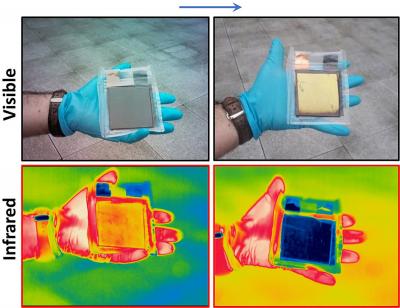Researchers at The University of Manchester’s National Graphene Institute have created optical devices with a unique range of tunability, covering the entire electromagnetic spectrum, including visible light.

The new study lists the possible applications for this ‘smart surface’ technology, that range from next-generation display devices to dynamic thermal blankets for satellites and multi-spectral adaptive camouflage.
The MLG device is laminated and vacuum-sealed in a low-density polyethylene pouch that has over 90% optical transparency from visible light to microwave radiation.
During charge (intercalation) or discharge (de-intercalation), the electrical and optical properties of MLG change dramatically. The discharged device appears dark grey owing to the high absorptivity (>80%) of the top graphene layer in the visible regime. When the device is fully charged (at ~3.8V), the graphene layer appears gold in color. The achievable color space can be enriched to include a range from red to blue using optical effects such as thin-film interference.
Professor Coskun Kocabas, lead author of the study, said: We have fabricated a new class of multispectral optical devices with previously unachievable color-changing ability by merging graphene and battery technology.
The successful demonstration of graphene-based smart optical surfaces enables potential advances in many scientific and engineering fields.
Previous studies have examined devices at specific wavelength ranges of microwave, terahertz, infrared and visible, using single and multilayer graphene. But it was the challenge of extending coverage to visible light while maintain optical activity at longer wavelength that required innovation in the structure of the device, overcoming established difficulties in the integration of optical devices with electrochemical cells.
Here we used a graphene-based lithium-ion battery as an optical device, he added. By controlling the electron density of the graphene, we are now able control light from visible to microwave wavelengths on the same device.
Nobel laureate Professor Sir Kostya Novoselov was a co-author on the paper and said: Few-layer graphene offers unprecedented control over its optical properties through charging. Such devices can find their applications in many areas: from adaptive optics to thermal management.

